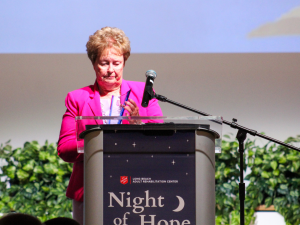Salvation Army provides aid in the Philippines, Indonesia and Samoa.
In the South Pacific and East Asia, Salvation Army relief teams have been hard at work helping thousands of people affected by natural disasters—notably in the Philippines, Indonesia and Samoa. Salvationists residing in these locations often ignore their own loss while reaching out to others. In the process they are transforming lives and reforming communities.
The Philippines
In late September two typhoons swept through the Philippines. The first, Typhoon Ondoy (also known as Ketsana), hit Manila and the surrounding regions, impacting the lives of more than four million people. The Salvation Army transformed its Central Philippines divisional headquarters in Quezon City into an aid center, stocking it with rice, sardines, noodles, blankets and mats and medicine. Within a two-week period, Salvationists and their helpers distributed more than 13,000 food hampers in eight cities and 22 villages at a cost of more than $125,000. Despite this huge effort, some people could not be reached because the floodwaters remained too high. It is estimated that in some places the flooding will take three months to recede.
Typhoon Pepeng (also known as Parma) struck the north regions of the country and then did a u-turn, settling in as a tropical depression, bringing more rain than anticipated. Early reports indicated more than two and a quarter million people impacted, with over 100,000 people having to stay in 281 designated evacuation centers. This was in addition to the 4.1 million people affected by Typhoon Ondoy. At this time, over 700 people have lost their lives in the two disasters.
Salvationists have joined rescue teams to clear roads and gain access to communities cut off by the floods. Many officers and volunteers worked for up to 24 hours, visiting local evacuation centers to offer support, joining teams distributing goods or operating feeding stations. Some opened their homes to those in need.
While the water has receded in some areas, much work remains to be done to help people rebuild broken lives. Damage to crops is a major concern. Major Daryl Crowden of The Salvation Army’s international emergency services traveled to the north of the Philippines to assess the situation and will work with divisional and corps teams to develop a strategy for the Army’s ongoing response.
Indonesia
On Sept. 30, 2009, a 7.6 magnitude earthquake struck just off the southern coast of Sumatra, Indonesia. The Salvation Army—in cooperation with local government officials and community leaders—quickly identified a location to begin the task of surveying communities and distributing aid.
From its base in the Pangang Pariaman sector, the Army is providing emergency assistance and medical services. In late October, the Army was seeing an average of 200 patients each day in a makeshift medical tent, the only service available for miles. In the first days of the crisis, the Army distributed 1,000 tents, 2,000 blankets and 5,000 packets of milk powder.
One community leader exclaimed: “We thank Allah for the The Salvation Army. No other organization has come to assist us.”
Two weeks after the quake, estimates placed 90,000 families homeless. Despite the daunting numbers, members of The Salvation Army’s “Compassion in Action” team—made up of 11 staff and volunteers from the Indonesia Territory—remain firm in their resolve to offer the best service possible.
Samoa
Salvation Army teams are still working to assist people affected by the Sept. 30 massive earthquake/tsunami in Samoa, American Samoa and Tonga.
An assessment team arrived in Apia (Samoa) on Oct. 3 and met with the New Zealand embassy, the Samoan Government Head of Emergency Relief and local village contacts to discuss the role and contribution of The Salvation Army.
The arrival of Major George Polarek from SAWSO (Salvation Army World Service Office) in the USA strengthened the team.
Plans are under way for several projects to help people rebuild their lives. In the village of Saleapaga—one of the places worst hit by the tsunami—The Salvation Army is working with Samaritan’s Purse on a response by the Apia Protestant Church and YWAM (Youth With a Mission) to provide tools. Fifty tool kits were delivered to the village on 6 October, allowing 46 affected families to set up traditional fale houses as transitional housing.
Further assessment will enable an appropriate response to be put in place. The Salvation Army is continuing to coordinate its response with the government and other agencies.
Donations to the “South Pacific and East Asia Fund” may be made online at www.salvationarmy.org.












